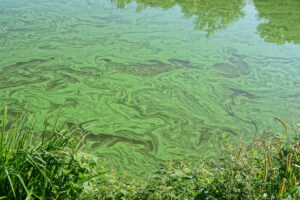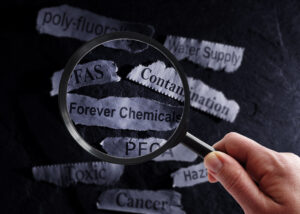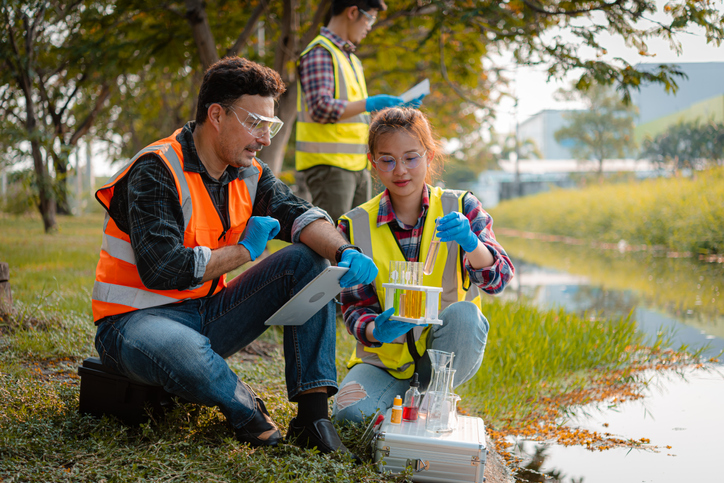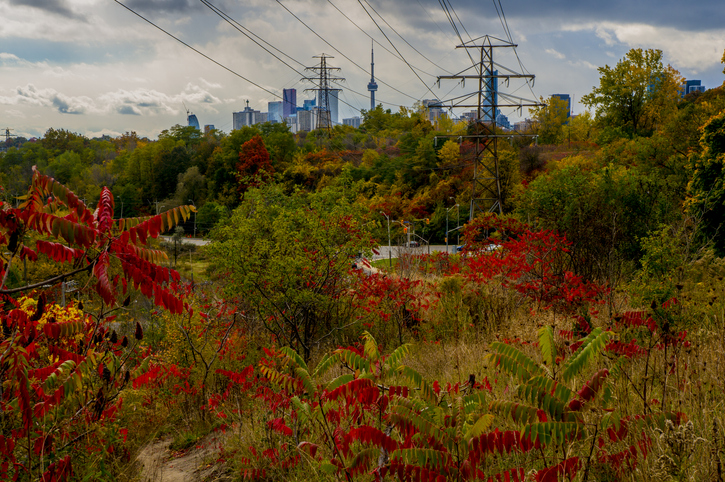Sunday, September 28, 2025
By Saul Chernos
PFAS levels contaminate drinking water in over 20 counties in North Carolina. Forever chemical found in mineral water from several European countries. Tests show high level of “Forever Chemicals” in Montreal firefighter bunker gear. Researchers say lithium-ion batteries part of PFAS problem. Could PFAS undermine COVID vaccination? Forever Chemicals are everywhere.
The news headlines are as relentless, persistent and everlasting as the roughly 14,000-strong class of synthetic chemicals they address. Perfluoroalkyl and polyfluoroalkyl substances are so stable and efficient they’ve become a staple in a dizzying array of consumer and industrial products. PFAS variants protect us from torrential downpours, keep paper straws and fast-food packaging intact, and ensure stain-resistant carpets, stick-free cookware and high-acting household cleaners perform as advertised. Perhaps most dramatically, firefighters wearing PFAS-insulated apparel used PFAS-bearing aqueous film forming foam (AFFF) to subdue the inferno that engulfed Lac Mégantic, Québec after an oil-bearing freight train derailed and careened into the town’s business core a decade ago.
Cultivating consensus
Notable achievements aside, however, PFAS have become one of the most talked about environmental bête noires of our time. “The bond between carbon and fluorine is one of the strongest in organic chemistry, so the main concern is their persistence in the environment and their tendency to bioaccumulate, especially in species at the top of the food chain,” says Sébastien Sauvé, a professor of environmental chemistry at the Université de Montréal.
Evidence linking at least some of the compounds to cancer, diabetes and multiple immune, metabolic and reproductive disorders has placed some of the chemicals, if not the entire class, in the big leagues of existential-level societal crises. PFAS have made our lives comfortable and convenient and quite convincingly thwarted lethal harm, yet some of these chemicals are classified in the Stockholm Convention list of persistent organic pollutants and have been subject to high-level cleanups and legislative actions.

Last March, Connecticut banned the release of wastewater sludge containing PFAS as well as its use in firefighting personal protective gear, and mandated labels when PFAS are intentionally added to consumer goods. Massachusetts followed soon afterwards with a prohibition, scheduled to take effect in 2027, in firefighting apparel. “This is an extraordinary day for firefighters across the commonwealth,” State Senator Michael Moore told journalists, citing an International Association of Firefighters assertion that cancer accounted for two-thirds of firefighter deaths from 2002 to 2019.
Still, the discourse is far from outright consensus. The firefighters association’s numbers didn’t distinguish between multiple carcinogens associated with close contact with fires, and the American Chemistry Council, an industry association, rebutted that not all PFAS variants have the same properties, harmful or otherwise.
“We have strong concerns with this legislation, including the overly broad definition of PFAS, and believe this bill may have unintended consequences for the performance of PPE that our firefighters need,” the chemistry council noted in a public statement, pointing out that PFAS are lifesaving for first responders because they offer a barrier to harmful chemicals, as well as water, while keeping apparel breathable and heat resistant.
Given the high number of PFAS variants, there’s little question they differ, often considerably, not only in terms of useful applications but also potential harms and degrees of risk. Furthermore, the tools and methodologies scientists use to identify and measure chemicals continue to improve so that detection, alone, doesn’t necessarily tell the full story. “We’ve analyzed drinking water from across the globe and we see it everywhere, even in bottled water,” Sauvé points out. “But that doesn’t mean that it’s toxic or that the levels are of concern. More that, if you have the right equipment and the right methods, you can find traces everywhere you look.”
Sauvé says there isn’t clear enough evidence, at least at this juncture, to categorically declare PFAS-bearing consumer products safe or unsafe because too little is known about too many variants and because concentrations can vary. Still, he points to significant and clear exceptions. Venues where PFAS-laden firefighting foams have been deployed are broadly considered high risk. Sauvé describes Lac Mégantic as among the largest and well-known instances in Canada of terrestrial contamination from firefighting foams, with pollution reaching the town’s sewers, adjacent waterways, and ultimately the St. Lawrence River, but he considers this the tip of a larger iceberg.
“The Lac Mégantic site has been cleaned up, but many other sites remain problematic,” says Sauvé, noting that landfills, firefighter training operations, military bases and airports, where suppressant foams are used, are often associated with water contamination, and that chemical manufacturing of PFAS and processing facilities using them are also worthy of attention.
Cleanup underway in North Bay
While there may be little if any actual production of PFAS in Canada, there’s no shortage of sites where firefighting foams have been used. A multi-year, $20-million remediation initiated last summer in North Bay, Ont. exemplifies the challenge of addressing significant concentrations.
From the 1970s through the 1990s, military trainees used AFFF foams in firefighting exercises at Jack Garland Airport, which abuts Canadian Forces Base North Bay. Over time, the foams seeped into the soil and groundwater, migrating off-site to nearby Lee’s Creek and then to Trout Lake, which supplies the city’s drinking water.
Measurements by the Ontario Ministry of the Environment, Conservation and Parks have detected an average of 56 nanograms per litre (ng/L) for a total of 11 known and identified PFAS variants, including perfluorooctanesulfonic acid (PFOS) and perfluorohexanesulfonic acid (PFHxS). This average falls within the Ontario government’s advice value of 70 ng/L in drinking water, though the federal government recently reduced its own drinking water threshold from 70 to 30 ng/L for the total sum of 25 specific PFAS. As well, the environment ministry has measured even higher concentrations in parts of Lee’s Creek, which remains under a fishing advisory, and as high as 772,000 ng/L in some of the creek’s naturally occurring foams.
As might be expected, local residents are following the situation closely. Brennain Lloyd with Northwatch, a regional environmental NGO, says results from five sampling stations spanning the lakes showed levels averaging 58.3 ng/L but with a range from 30 to 109.3 ng/L.
“Those levels are definitely grounds for concern,” says Lloyd, adding that Health Canada has published an objective maximum of 30 ng/L for the sum of all PFAS in drinking water, while some jurisdictions outside Canada have objectives as low as the single digits. “Local residents are concerned but have been surprisingly patient as the agencies progress slowly and share a minimal amount of information,” Lloyd says. “When I pour a glass of water in my kitchen, I’m drinking water that’s contaminated with PFAS. It’s clear, it’s cold, it tastes great, but it is toxic.”
Karin Pratte, director of water, wastewater and environmental services with the City of North Bay, says the City, the Department of National Defence, the Ontario environment ministry, and the North Bay Parry Sound District Health Unit formed a working group in 2016 to address the situation. “Because it was an emerging contaminant at the time, there wasn’t a lot of data to speak to what the impact of the PFAS would be,” recalls Pratte.

The City did initial sampling in and around the airport to understand the scope of the contamination, retained Jacobs Consultancy Canada to conduct more extensive sampling and testing to identify areas deserving particular attention, and negotiated with DND to finance 97 per cent of the cost of remediation at the municipally owned airport. In 2023, the City of North Bay contracted Clean Harbors Canada to handle actual remediation work, which included the disposal of more than 20,000 tonnes of contaminated soil at an approved site in southern Ontario.
Crews expect to wrap up cleanup work this spring. “We’re mixing in a remedial amendment at the base of the excavation where it intersects with the water, and then backfilling,” explains Carol Mowder, a senior technical consultant with Jacobs. “We’ve done a pilot test for injecting colloidal activated carbon into the groundwater, and we’ll be continuing to monitor that to see how far it’s distributed and its effectiveness.” The pilot test data will then be used to design a remedy to treat groundwater before it exits the property.
While the undertaking at Jack Garland Airport is well underway, it won’t address PFAS that have already migrated off-site and into Trout Lake and its surrounding aquifer. Pratte says treatment methods, including granular activated carbon and ion exchange, are available to reduce PFAS concentrations in drinking water, and the City recently asked Jacobs to undertake a drinking water study to explore potential treatment options. “It hasn’t been completely finalized,” she says, adding that its findings remain confidential because they’re pertinent to ongoing negotiations with DND.
Research and regulation
Complicating matters is that little is known about so many variants — a fact Environment and Climate Change Canada tacitly acknowledged last year when it issued a one-time reporting mandate. Under the Canadian Environmental Protection Act (CEPA), parties to the manufacture, sale, offer for sale, import, and use in 2023 of 312 specific PFAS variants were asked to report their interactions.
Joanna Vince, a partner with Willms & Shier Environmental Lawyers, says day-to-day rulemaking and enforcement in Canada are largely handled at the provincial and territorial level. However, toxic substances are areas of federal jurisdiction and may be guided by federal standards, and so the federal reporting requirement is meant to gather baseline data to support future rulemaking. “Governments have to start somewhere,” says Vince. “They don’t know who’s importing it and using it, or how much. It’s step one.”
For the time being, while the federal government examines the new data and determines its next steps, CEPA already recognizes a handful of PFAS variants as toxic under and in some cases limits their manufacture, use and sale. The federal government also introduced drinking water guidelines for some of the chemicals in 2018. Then, in 2023, the government released a draft report on PFAS acknowledging they have the potential to harm the environment and human health, and an updated report last July took the assessment of certain classes even further.
“This is just showing that the federal government is engaging in the issue,” says Vince. “They’re continuing to do research to better understand how they want to regulate, whether it’s bans or restrictions.”
Another key to understanding and regulating the multitude of variants is quantifying their actual presence. SGS Canada specializes in testing, inspection and verification of a wide range of industrial chemicals, and its SGS AXYS lab in B.C. developed the U.S. Environmental Protection’s Agency’s Method 1633, a standardized procedure the agency implemented last year to assess 40 PFAS in wastewater, surface water, groundwater, drinking water, soil, biosolids, sediment, landfill leachate, and fish tissue.

“It’s a standard best-practice method for PFAS measurement using mass spectrometry,” explains Bharat Chandramouli, a product director with SGS Canada. Analysts use solid phase extraction to isolate PFAS and adsorb it into a solid stationary phase. They then use a liquid chromatograph and mass spectrometer to separate complex components into specific compounds of interest and, in turn, produce a concentration measurable at extremely low levels. While the technique is currently commercially available for only 80 to 100 PFAS variants, other techniques can be employed to pursue additional, known variants, according to Chandramouli.
Canadian governmental agencies have tapped into Method 1633 for various measurement purposes. Last year, Health Canada employed it in the course of issuing its drinking water quality objective to address 25 noteworthy PFAS. The Ontario environment ministry has also authorized SGS to use Method 1633 for drinking water testing in Ontario. In fact, Chandramouli says SGS was involved in the early stages of research at Jack Garland Airport and used Method 1633 to measure PFAS. “The nice thing about the Canadian system is we take the best methods from every regulatory agency available and, as long as it’s applicable to Canadian work, we can use it here.”
With PFAS so prevalent and the vast majority of class members continuing to defy even basic identification and measurement, remediation stands to require patience and a persistence to match that of the forever chemicals themselves.
“PFAS are so ubiquitous that it’s not feasible to expect to be able to tackle PFAS everywhere,” says Stefano Marconetto, emerging contaminants practice lead with engineering and consulting firm WSP. “The key is to focus on where the main problems are. That means the most PFAS in terms of mass, not just concentration, and where the most sensitive receptors or the biggest issue may be for people and the environment. It’s critical to be able to focus on the areas with the most elevated risks, to limit exposure. And, as we’re able to tackle and address those, over time we can then expand to others.”
Call to comment
On March 6, 2025, the federal government released the State of Per- and Polyfluoroalkyl Substances (PFAS) Report. The report concludes that the class of PFAS, excluding fluoropolymers, is harmful to human health and the environment. Beginning in 2025, the Government of Canada will also require manufacturing and other facilities to report the use of PFAS to the National Pollutant Release Inventory. This data will improve understanding of how PFAS are used in Canada, help evaluate possible industrial PFAS contamination, and support efforts to reduce environmental and human exposure to harmful substances.
Canadians are invited to comment on the Risk Management Approach and the Proposed Order to add the class of PFAS, excluding fluoropolymers, to Part 2 of Schedule 1 to CEPA, until May 7, 2025.

Saul Chernos is a freelance writer based in Toronto, Ontario.
Featured image credit: Getty Images.
To read the original version of this article, which provides a multimedia experience, please click here.
To ensure you receive updates on related content, please register for your free subscription here.












